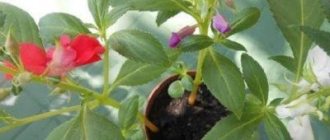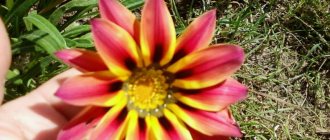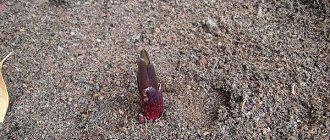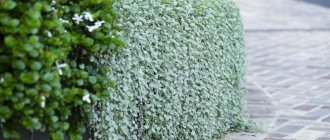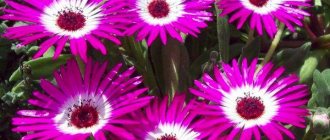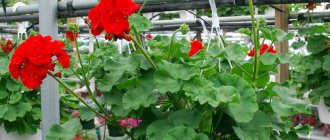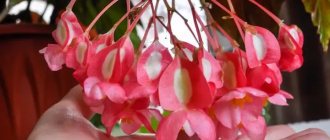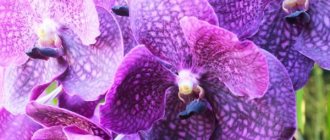The plant can be herbaceous or subshrub. Initially, balsam grew in the tropics; the supposed homeland of this flower is the island of Zanzibar. The flower appeared in Europe at the end of the sixteenth century, where cultivated varieties of balsam were bred.
With proper care, balsam blooms almost all year round.
The flowers of the plant are large and bright, most often red, but pink, yellow, orange, white, and burgundy are also found. There are varieties with two-color flowers, i.e., a contrasting “eye” in the center of the flower. The leaves are usually dark green, sometimes burgundy or variegated.
Advice!
The plant is moisture-loving and requires regular, frequent watering, especially in the warm season. In summer, the balsam should not be exposed to scorching sunlight; it is necessary to shade the plant. In winter, it is not recommended to heavily moisten the soil to avoid hypothermia. Drafts are also detrimental to the flower.
Impatiens do not need to create additional conditions; this flower feels great at the temperature and humidity of an ordinary living space.
Look at the photo of what the balsam looks like:
Planting seeds and cuttings
Planting balsam is done in two ways:
- .
It is considered a simpler way to plant a plant and is recommended for beginning gardeners who want to preserve the quality of the variety. For planting, cuttings obtained after spring pruning of the plant are used. The cut shoot is placed in water until roots appear, this happens after about 2 weeks.After this, the sprout is planted in sand or a substrate prepared from a mixture of peat and perlite in a 2:1 ratio. When the flower gets stronger, it is transplanted into a larger container with regular soil for adult plants.
- .
Used by experienced gardeners and, as a rule, for growing garden varieties. However, it can also be used for indoor plants. It is important to remember that balsam grown from seeds may not have the characteristics of the selected variety. For planting, seeds are placed on the surface of the substrate.It is allowed to slightly deepen the seed, but it is not advisable to sprinkle it on top. After this, the container is covered with film or a glass cap. After about 10 days, sprouts with two leaves appear. This means that the seedlings can be transplanted into separate pots.
You will learn all the details of plant propagation by cuttings and seeds by reading.
It is necessary to replant balsam in order to replace the old depleted soil with new and nutritious soil, as well as to provide additional space for root growth.
It is important to remember that some tightness is even beneficial for this flower.
, because balsam blooms only after the root system fills the space of the pot. If the container is too large, all the energy and nutrients of the balsam will go to the development of roots, and not to flowering.
Transplantation is carried out once a year - in spring, or twice a year - in spring and autumn, depending on the intensity of flower growth. It is also necessary to replant a plant purchased in a store 2 weeks after purchase - this is the time the plant needs to adapt to new conditions. Read about the intricacies of transplanting balsam and subsequent care for it.
What to plant in the flowerbed in spring?
Waller's balsam is a perennial, but outdoors it does not tolerate harsh winters and freezes to death. In the fall, take care of spring plantings: dig up a bush with a lump of earth and plant it in a pot. Caring for a flower indoors will not take much time - you only need watering and good lighting. Tall varieties will have to be replanted every year. You can use 2 methods: sowing seeds and cuttings.
Cuttings can be prepared in any season. Select a healthy, strong bush and cut off the tops of shoots up to 10 cm long with three leaves. You can buy a pot of Waller's balsam at a flower shop, place it in a dark place so that the shoots stretch out, and then cut several cuttings from one bush. Dip the cuttings in a growth stimulator and lower the bottom part into water, soil or wet sand. When the branches send out roots, transplant them into separate containers for further development. Make sure the cups have good drainage holes and do not water the seedlings too much. Provide them with proper care, and in early summer they will grow into mature bushes.
The spring frosts have ended, and planting of balsam in open ground begins. A few hours before transplanting, water the seedlings and cuttings so that the soil in the cups is well moistened. Make holes no closer than 30 cm from each other, put a little humus on the bottom and spill with water. When planting, carefully straighten the roots of the seedlings, fill the holes and lightly compact the soil. If you don’t want to constantly loosen the soil and fight weeds, cover the surface of the flowerbed with a layer of mulch at least 5 cm thick, and caring for the flower garden will become very simple.
Required soil
This flower requires loose soil with low acidity. An excess of nutrients in the soil is not desirable, as it will lead to the growth of green mass and weak flowering. In a specialized store you can purchase an earthen mixture for flowering plants, or prepare the soil yourself:
- The first option for homemade soil is a mixture of leaf soil, turf, humus, sand and peat in a ratio of 2:2:2:2:1.
- A mixture of leaf soil with peat and river sand (2:1:1) is also used. It is important to remember that all components taken from the street must be disinfected.
Reference!
Despite the fact that balsam is very moisture-loving, a thin layer of drainage in the pot is still very desirable. They can serve as small pebbles or pebbles, laid in a layer of no more than 2-3 cm.
Transfer
It is recommended to replant annually, preferably in the spring. Over the course of a year, the soil is depleted, which leads to the bush beginning to wither. Vanka doesn’t like big pots, which means you can use the old one, and if the bush has grown too large, then divide it and plant it in small pots. The transplant will benefit the plant, and after a couple of days, it needs to be fed.
- The transplant process itself is not complicated:
- We free the plant from the old soil;
- The roots can be washed a little or placed in a container with water;
- Place the sprout in a pot with the prepared soil mixture and sprinkle with soil;
- After this, water it a little, add more soil and compact it with a spoon or spatula.
After the soil in the pot has settled, you can sprinkle it with sand or fine gravel.
How to properly care?
It is extremely important for balsam to receive sufficient moisture.
In summer, the flower needs abundant watering, daily or every other day, depending on how quickly the top layer of soil in the pot dries out. Under no circumstances should the soil be allowed to dry out.
In winter, watering is reduced, especially if the plant is in a cool room. Usually, in the cold season, 2 waterings per week are enough for balsam.
Can I spray with water?
Spraying can be carried out if the air in the room is warm and dry.
In addition to additional hydration, this procedure serves as a prevention against the appearance of spider mites. Impatiens should be sprayed once every 2-3 days.
After spraying, it is necessary to keep the plant in the shade, since bright sunlight can burn wet leaves.
It is also important to avoid drafts to avoid hypothermia. For the same reason, it is not recommended to spray balsam in winter.
Top dressing
During flowering, balsam requires feeding.
Fertilizer should be applied once every 10 days from the beginning of spring to autumn, until the plant enters a dormant period, alternating nitrogen and phosphorus fertilizing. Among organic fertilizers, the main source of nitrogen is bone meal, and phosphorus is wormwood compost.
Nitrogen is necessary for balsam for the successful development of green mass, and phosphorus promotes high-quality flowering. Read about how to properly water and what to feed the plant for abundant flowering.
How to pinch?
To improve flowering and form a neat bush, in the spring it is necessary to pinch out the balsam, i.e., remove the upper part of the shoot.
Along with pinching, damaged leaves and wilted flowers are usually removed.
Thanks to this, the flower maintains a neat appearance, and also reduces the risk of certain diseases and pests.
Important to remember:
For dwarf varieties of balsam, pinching is not required.
Trimming
How to prune a plant correctly and when should it be done? Pruning is carried out in March, and young shoots of balsam are cut off, which can be used to propagate the flower. During pruning and pinching, it is necessary to increase watering so that the plant can more easily endure the painful procedures.
In order for a flower to develop well and bloom actively in the warm season, in winter it is necessary to provide it with a period of rest. This will help the plant rest and gain strength for spring. Receiving less sunlight, balsam can shed its leaves.
If proper care is taken, this phenomenon is not a cause for concern.
Lowering the temperature in winter is a desirable, but not necessary condition for balsam. If the plant is placed in cooler conditions during wintering, then you need to remember that the indicator should not be lower than +16 degrees. Watering is gradually reduced from daily to once every 3-4 days.
Accumulation of water in the pan is not allowed. Fertilizers are excluded completely or applied no more than once a month. Nitrogen and phosphorus fertilizers should be replaced with potassium-phosphorus fertilizers.
We wrote in more detail about growing and caring for balsam at home.
The most common types
The extensive family includes many amazing representatives:
- garden;
- Waller;
- terry;
- Impreza;
- Hawker;
- New Guinean.
Vanka wet, touch-me-not, whim, light - all these are names of the same plant, balsam. And all the names are based on fairly solid ground. For example, “Vanka is wet”, a cute flower was obtained because of the crystalline droplets protruding on the edge of the leaves. But the “whim” is due to its capricious nature: when the earthen clod dries out slightly, the leaves of the plant hang sadly. At the slightest touch, the leaves turn yellow and fall off, the flowers do not develop, and, lightly touching the fruits, they instantly shoot out, scattering seeds around. Based on these signs, people's rumor called balsam touchy. Delicate flowers of bright colors, scattered in a chaotic disorder throughout the bush, similar to lights, explain another nickname - “light”. Summarizing the above, we can accurately characterize an amazing, but such an ordinary and widespread flower as balsam. So, abundant watering, careful attitude, a healthy lifestyle (does not like tobacco smoke, it is especially destructive for young plants), adequate lighting, add the obligatory fertilizer to this and get completely unpretentious care. It is precisely because of this that he has firmly settled in the homes of even those who are not too keen on growing indoor plants...
Different subspecies of balsam differ from each other in the shape of flowers, leaves and even the structure of the plant. There are about 600 different types of balsams in nature, but they all have common characteristic features.
In the summer, balsam can decorate your balcony and garden. In the fall, without waiting for the very first frost, balsams are dug up and stored until next summer in a warm room.
THE LEGEND OF BALSAMINA
In ancient times, when wars raged on earth and the strong part of humanity was forced to defend their homes and families with weapons in their hands, a beautiful girl lived in one village. She had a lover. When he once again got ready to go to war, he asked his beloved to put a light at the window so that when returning home he would not go astray. The beauty did just that. But the guy was not destined to return to his family; he died heroically on the battlefield. But the girl did not believe the rumor, did not extinguish the light in the window and continued to wait. The years flew by, she grew old and soon died. In place of the brightly glowing light, a touching plant appeared, nurtured by love, watered with bitter tears and fertilized with fidelity…. BASIC CARE ADVICE
Moisture and partial shade are what balsam needs to feel good. It bravely tolerates the sun, but it is best to place this flower on windowsills facing east or southeast. Impatiens are a heat-loving plant - so it must be kept warm, 18-20 degrees in summer. For the sprouts to bloom, the temperature on the windowsill should not be less than 15°C, even in winter. As temperatures drop further, leaves may fall off. Plants love diffused light; in summer they must be protected from the midday sun. Impatiens are moisture-loving, but cannot tolerate stagnant water. For the plant to bloom, the pot does not need to be large. Flowering is promoted by regular fertilizing, but if there is a lot of nitrogen, the green mass increases, and the number of flowers decreases. SOIL FOR BALSAMIUM
I use a regular lightweight substrate for flowering plants. Heavy soil, rich in minerals and nitrogenous compounds, will lead to a lot of leaves and few flowers, and the plant may not bloom at all.
As for filling the flowerpot, there should not be a lot of soil, otherwise the plant will be late flowering, “developing the territory.” A pot of soil that is too large will cause the young home balsam to grow into a bush, and it will not have time for flowers. For full flowering, balsam needs a small pot and a moderate amount of soil. Its roots should fill the flowerpot. If I want to get a beautiful bouquet on the windowsill, then I plant 2 balsam cuttings with flowers of different colors in one wide flowerpot. They get along great.
WATERING FOR ROOM BALM
Don't skimp on water! Watering is the most important agrotechnical requirement for caring for balsams. The soil should always be moist, but stagnation of excess water is dangerous because sciarids - tiny flying midges - will appear in the soil. However, from time to time you need to arrange stages: dry - wet!
In summer I water indoor balsam every other day, in winter once every 3 days or 2 times a week. You need to water along the edge of the pot so that water does not fall on the root collar of the plant.
The water for irrigation is taken to be settled and soft. If limescale has formed on the surface of the soil and the plant is sick with something, this indicates alkalization of the soil as a result of watering with hard water. Replacing the top layer in the pot can help here. You can water in a tray, then the soil will get wet and there will be no limescale deposits on the soil.
You should spray if the air temperature is more than 20 degrees, but avoid getting it on the flowers.
From time to time, but not too often, it is necessary to loosen the top layer of soil (to a depth of no more than 1 cm). Loosening allows the root system to breathe. FERTILIZER FOR ROOM BALM
From spring to autumn, the plant is regularly fed with liquid mineral fertilizer once every 2 weeks. Do not overdo it with nitrogen fertilizers! It is also good to feed by spraying, especially young cuttings.
Feeding should be stopped in late August and not carried out throughout the winter. You should also not feed sick plants. Feed plants after transplantation only after 3 weeks. PROPAGATION OF BALSAMINA BY SEEDS AND CUTTINGS
Impatiens can be propagated by seeds, which need to be sown in moist soil and covered with a transparent film to create a greenhouse effect and retain the moisture these flowers need. Sown in early spring, the seeds germinate in the light. The plant blooms 3-4 months after sowing.
In spring and summer, balsam can also be easily propagated by apical and stem cuttings: Cut off the top of the cutting 5-7 cm, with 2-3 internodes, remove the bottom 2 leaves, place the cutting in cold boiled water and cover with a greenhouse. After 5-10 days, roots will appear and you can plant them in a small pot. You can also root cuttings in the ground.
Spring cuttings produce plants that bloom in summer, and cuttings taken in July-August produce plants that bloom throughout the winter.
POSSIBLE DIFFICULTIES
Falling leaves. Leaves usually fall off during prolonged cooling. Other reasons may be irregular watering and severe pest infestation.
Wilting of leaves. Insufficient watering. Leaves may droop in summer a day after watering. The only way to combat this problem is frequent watering, but you do not need to keep the plant in a saucer of water all the time.
Weak flowering. There may be several reasons. The most likely ones are lack of light, lack of nutrition, excess nutrition, too low a temperature or premature transplant.
Elongated stems. This phenomenon is caused by too high a temperature combined with a lack of light, although in some traditional varieties, even under favorable conditions, the stems quickly begin to become bare. Root cuttings of a modern compact hybrid and discard the old plant.
Flowering did not occur. The usual reason why flowering does not occur in an adult plant is replanting. The balsam should sit in a tight pot.
Root rotting. Overmoistening, especially at low temperatures and insufficient lighting. In winter, always reduce watering, water very carefully if the temperature does not exceed 15 degrees.
Fall of flowers. The usual reason is lack of light. Other causes may be dry air, dry soil, or red spider mite infestation.
PESTS
Impatiens are most often attacked by aphids, whiteflies and spider mites, which appear due to too dry air. If not properly cared for, it is affected by gray rot. Pruning, replanting balsam
In the spring, during transplantation, balsam is cut to half the length of the shoots.
Impatiens will bloom better if you do not replant them too often and leave the plant in a slightly cramped pot.
To make the bush more compact and bloom profusely, pinch out the balsam when it reaches the desired length. This stimulates the development of new shoots. When the side shoots start to appear, they are also pinched. This way we form a thick bush. The more shoots there are, the better the flowering will be.
After two years of life, balsam loses its attractiveness, so once every two years the plant should be renewed by cuttings, i.e. grow new balsam.
It is not without reason that balsam has been dubbed as touch-me-not. The fact is that this plant loves light and warmth very much,
but he simply cannot stand the coolness, let alone drafts. It is this fact that should be taken into account when caring for balsam.
What time of year should you plant?
It's no secret that proper planting guarantees the plant a long life, but the wrong approach to this procedure can ruin the flower even with further proper care.
When it comes to garden balsam, it is important to remember how heat-loving this flower is. This plant has fleshy leaves that mostly contain moisture.
The cold starts the processes of water freezing, and the plant stops receiving nutrition. In such conditions, balsam dies.
Therefore, the best time for planting is considered to be late spring, mid or late May, when the air has already warmed up and there is no rain or wind.
Place for landing (thermal conditions, light conditions)
The correct landing site plays a very important role.
. After all, if you plant balsam in the shade or in a draft, you run the risk of soon noticing how this flower is dying.
Impatiens does not tolerate shade; it needs as much light and warmth as possible.
If you want to admire a flower
all summer, avoid shady areas. But open areas involve strong gusts of wind, so there should be fences in the path of bad weather that will prevent the flower from experiencing strong gusts.
Many gardeners believe that planting balsam in the ground during rain is a positive factor.
The soil will be wet, the flower will immediately receive the necessary moisture, and will adapt faster to new conditions. In fact, this is far from the case.
When transplanting a flower, it experiences severe stress, so it is necessary that the soil is warm and preheated.
In May, the ground is not yet warm enough, and if it is wet with rain, it may even turn out to be cold for the flower. Impatiens plant is very delicate, so any deviation from the usual conditions of existence can play a cruel joke and the flower can die.
Priming
Balsam should only be planted in fertile soil enriched with nutrients and microelements for plants.
If you are not sure that the soil is rich enough in necessary substances, fertilize it a few days before planting.
It is advisable to repeat the procedure several times a month, because balsams are very sensitive to soil.
If you have analyzed your soil and know that it is slightly acidic,
then you can be sure - this is an ideal environment for the growth and development of balsams.
Impatiens need to be planted at the same depth as they were planted in the pot.
Watering
As you know, balsam loves moisture very much, which is why this plant needs constant watering.
However, ordinary water
not suitable for this. Balsam is a delicate plant, so in its case, you need settled water, which is distinguished by its softness.
Water is too hard
leads to the fact that the plant can die in a matter of days due to the fact that the soil is saturated with alkaline substances.
is allowed once a day,
at the certain time. Do not overwater the flower; the soil should always remain slightly moist. Too much water can cause the roots to rot.
It is also important to know exactly how to properly water balsam. You need to water in a circular motion,
describing a circle around the crown. Thus, the flower will not have an excess or lack of moisture.
Caring for balsam outdoors
Impatiens also need moist air. That is why sometimes, in hot weather, the plant should be sprayed with water. It is also useful for the roots to also receive oxygen in the proper amount, so loosen the soil once a week.
If the air temperature outside has risen above twenty-five degrees,
If possible, balsam should be sprayed several times a day.
Do I need to fertilize, what, when and how much?
Like any other plant, for enhanced growth and proper development of the plant, balsam must be fed.
Buy special mineral solutions,
produced specifically for balsam, and in their absence - flower food.
Feeding should be done from May to August. But if the fertilizer contains potassium and phosphorus, then it can be continued until the first frost.
Be aware that it is not recommended to give the plant useful minerals and substances immediately after planting.
Gardeners are confident that three weeks must pass before the plant establishes itself in a new location, and only then can the addition of minerals be included in the care process.
Possible problems
When growing indoor balsam, you may encounter the following problems:
- The plant does not bloom, in most cases, due to unfavorable factors. Typically, flowering does not occur if the balsam is planted in a pot that is too large, does not receive enough water, or due to excess nitrogen, which it receives from fertilizers.
- Yellowing of the leaves is a signal of a lack of moisture in the soil. In addition, the leaves may turn yellow as a result of a burn if the flower is located in direct sunlight. In winter, this sign indicates hypothermia of the balsam.
Features of cultivation
There may be other problems when growing balsam. The most common are:
- Why do balsam buds fall off? This situation occurs when the bush is poorly cared for, when the indoor air is dry and there is insufficient watering, it is too cold and dark, and also when the bush is overfed with fertilizers.
- Why do balsam leaves turn yellow? This occurs due to moisture deficiency or sunburn if the pot is placed in direct sunlight. In winter, the leaves may turn yellow due to low indoor temperatures.
- Pests that attack the bush - whiteflies and spider mites - appear when the room is too dry and in the heat if it is not ventilated. The plant should be properly cared for.
Diseases and pests
Like many other indoor plants, balsam is susceptible to attack by pests and the appearance of. The following are considered the most common for this flower:
- Whitefly
- an insect dangerous to balsam, appearing in a dry, damp room that does not receive fresh air.Important!
For prevention, regular spraying and ventilation of the room with flowers is necessary. To get rid of whiteflies that have already appeared, use insect repellent tape.
- Spider mite
- feeds on the sap of balsam leaves, which causes the leaves to wither and curl. It appears, like the whitefly, when the flower is kept in the wrong conditions. Maintaining air humidity and good ventilation will help prevent the appearance of such a pest. - Soil mold
- occurs when there is excess moisture. Despite the fact that balsam is a moisture-loving plant, it is important to ensure that the soil does not sour. If the top part of the soil is still covered with mold, it is necessary to remove the affected layer of soil and fill in a new one.
Subtleties of watering
Vanka loves moisture very much, which means he needs frequent but moderate watering. So, in the summer it is recommended to water a little, but every day, or more abundantly, but every other day. In winter, the plant should be watered no more than 2-4 times a week if the room is hot.
In this case, care should be taken to ensure that water does not stagnate in the soil cavities. If stagnation occurs, you can either add soil, put the flower in a warm place so that the water evaporates, use cotton wool, or simply drain the excess water.
Choosing a landing site
Impatiens, although a houseplant, feels great not only on window sills, but also in tubs, on the balcony, outside and fits perfectly into flower arrangements in flower beds. The main thing is to choose a good place for it and choose the right soil. Impatiens do not tolerate direct sunlight, but do not like strong shade. The best option for them is sun up to 12 o'clock and partial shade the rest of the daylight hours. Hills of terry balsams look beautiful in a combination of tall plants (roses, irises), against the background of subulate phlox, hosta, heuchera. They really look like bright lights when planted in the company of ground cover plants.
In tub culture, balsams do not react well to pot neighbors and prefer to grow on their own in the same container. The larger and wider the pot, the more luxurious the plant will be. If you plant a small rooted cutting in a hanging pot, then in a month you can already get a cascade of bright flowers.
It is important to know that the color saturation of the petals depends on the place where the plant is planted. In the floor shade, the flowers have a brighter color and give off a silvery tint. In strong sun, balsam inflorescences may not even bloom or lose their brightness and fade.
Description of the plant
The plant takes root well and feels great on the windowsill in a pot. It is loved by gardeners for its constant flowering and easy care. Its natural habitat is subtropics.
It is still found wild in the subtropical climates of India, Africa and North America. The flower came to Europe at the end of the 16th century and took root perfectly. It was brought to Russia only in the 19th century.
Plant species common in Russia have succulent and brittle stems with a fibrous root system.
Its leaves are oval or heart-shaped, tapering at the beginning, and widening closer to the petiole.
Their edges have a jagged edge with small or large teeth, ending in a small spine.
The color saturation of the leaves depends on its type. In Russia, gardeners usually breed plants with light or rich green leaves. There are also types of balsam with dark green leaves with a lilac or brown tint. Veins clearly appear on the sheet, having a color one tone lower than it.
The flowers of the plant have 5 petals and are colored in different colors: pink, red or pale pink. There are varieties with two-color flowers: cherry, orange, white, as well as those with rose-shaped buds, double and semi-double petals.
Faded buds form green fruits, which, when ripe, form a dry capsule.
Indoor balsam beauty of flowering how to care
How to preserve balsam in winter
In the warm season, balsams do not require care. They only need to be protected from direct sunlight and provided with regular watering with warm water. Weekly fertilizing with complex fertilizers will increase the intensity of flowering, but if they are neglected, the plants will still be covered with flowers all season.
For a gardener, it is not so difficult to grow balsam from cuttings as to preserve it in winter. Potted flowers react especially painfully to changes in temperature. Only 50% of plants can adapt to indoor conditions after being outdoors.
A few tips will help keep losses to a minimum:
- Bring pots of flowers into the house when the room and street temperatures are still at the same level. Most often this happens at the end of August.
- Place plants in the house on the side on which the flower grew or was previously located.
- An open window will help the plant acclimatize faster.
- Reduce watering and fertilizing.
- Carry out morning and evening spraying.
- If the plant begins to shed its leaves, then you need to wait until the leaves fall and trim the tops. In a week, newer shoots will appear along the length of the branch.
Most gardeners agree that the best way to preserve the balsam variety is to take cuttings from the mother plant in early August and take the cuttings from the rejuvenated bush in February-March. This will protect the plant from many diseases, and the gardener from problems and dancing around the bush, which will try with all its might to release young cuttings in November-December.
Location
In an apartment during the cold season, it is better to place the flower where there is direct sunlight, that is, on the south side of the apartment. In summer, choose a place where there is enough light, but not too dry. It would be favorable to place it on the western or eastern side of the house. The plant is light-loving, but prolonged exposure to direct sunlight is undesirable.
Balsam
In summer, Balsam needs to be sprayed more often. The most optimal temperature for the plant is 15 degrees in winter and no more than 20 in summer . If you decide to plant balsam in open ground, then it is better to choose a shaded area with enough light.
With proper care, it is able to delight with its flowering until the first frost. Thus, for a wet roly-poly you need to find a bright place. Otherwise, due to a lack of light, its stems will stretch upward, and it will bloom poorly.
Indoor flower Vanka wet photo:
Balsam bouquet
Balsam propagation
Impatiens are propagated by cuttings and seeds. When cutting, young, healthy branches are cut from the bush with a sharp knife or blade and placed in a container with boiled, chilled water for several days, or the cut site is dried for 10-15 minutes and immediately planted in the soil. In the latter case, the planted cuttings are placed in a greenhouse, since balsams quickly lose the elasticity of the leaves and stem.
When propagated by seed, shoots emerge on the second or third day. It is important to maintain temperature conditions and normalize humidity so that the plant does not become infected with blackleg. After the appearance of the second true leaf, the young shoots are transferred to a separate container or planted in a permanent place.
Impatiens is a short-lived plant, but its beauty and rich flowering compels flower growers around the world to plant this miracle on their plots, balconies, and overcome all difficulties in order to preserve the desired variety.
Decorative flower “Vanka wet” or as it is also called Indoor balsam - care at home and its propagation is not difficult. But this floral fireworks can decorate the interior of any home with a lush bouquet of bright, picturesque flowers. All kinds of bud colors, depending on the type of indoor plant, with proper care will delight their owners with colorful flowers framed by lush green foliage all year round.
Sowing balsam for seedlings
Typically, Waller's balsam is grown for summer flowering in the garden, sowing the seeds in March-April. However, if you have lighting and, most importantly, a great desire to decorate your windowsill with a bright flower, without waiting for spring, you can start sowing “light” seeds even in the middle of winter.
Flowering of most modern hybrids begins 3 months (90-100 days) after germination. Thus, if you decide to sow a “light” in December-January, you can get flowering balsam bushes by March 8th. But first, of course, you need to decide on the variety.
Whenever you start growing balsam from seeds - in early winter or traditionally in mid-spring - it is important to consider some of the characteristics of this plant. In particular, if stored improperly, balsam seeds quickly lose their viability.
Practice shows that it is much safer to purchase fresh “professional” seeds in online stores.
Balsam seedlings appear faster in the light. Nevertheless, it is recommended to place the seeds not superficially, but slightly deepen them, so as not to get seedlings “in caps” (with a seed shell that prevents the cotyledons from opening).
Individual balsam seedlings initially lag significantly behind the main mass, have clumsy cotyledons and small true leaves, so it is better to immediately remove defective specimens, because in the future they will never develop into quality plants.
Impatiens is a tropical flower; its seeds require high temperatures to germinate, so it is better to keep the containers close to the radiator. Subsequently, it is also necessary to provide the seedlings with a temperature of at least 20 degrees (keep in mind that it is usually cooler in the window than in the main room) and protected from drafts.
On average, it takes 7-10 days for Waller's balsam seeds to germinate. After the emergence of seedlings, a phytolamp should be immediately installed over plants sown in winter, which should work for at least 8-10 hours a day.
There is absolutely no need to rush into picking, since even grown seedlings will tolerate replanting well. When 2 to 4 true leaves appear on the plants, the seedlings can be planted in separate containers. At the same time, take into account that “lights” do not bloom well in pots that are too spacious. Therefore, the first container for young balsams should be pots with a volume of 300-500 mm cubic, and 1.5 liter bowls are suitable for adult specimens.
Buds on young plants begin to appear when the bushes grow more than five pairs of leaves.
Balsam Accent series. © Lyudmila Svetlitskaya
Hybrid balsam “Apple blossom” (Athena Appleblossom). © Lyudmila Svetlitskaya
Balsam “Strawberries and cream”. © Lyudmila Svetlitskaya
What is indoor balsam
The perennial or annual flower belongs to the Balsamaceae family. The bushy plant is distinguished by straight, succulent and fleshy shoots. On the stems, serrated, lanceolate or entire leaves without stipules are located in whorled or opposite order. Their color varies from green to reddish-bronze depending on the variety. The flowering period of "Impacts" continues from May until December inclusive.
The plant comes with smooth or double flowers, which can have a variety of colors in their collections: white, crimson, pink, red, lilac, yellow, orange, and also all kinds of shades of the listed palette. There are varieties of Balsam with an original combination of several colors of one flower (two-color). The fruits of the plant are multi-seeded capsules; touching them will cause them to crack.
Homeland of Balsam
“Vanka wet” comes from the island of Zanzibar, eastern India, southern China, Malaysia, so Balsam prefers subtropical and tropical climates. This origin explains the flower’s love for warmth, light, and abundant soil moisture. Balsam, brought to Europe in 1596 from Africa and Asia, quickly gained popularity among the local population.
In England, for its rich and long-lasting flowering, it was nicknamed “Business Lizzy”. From the Austrians, the flower miracle received the nickname “Beautiful Wreaths”. But “Vanka wet”, the plant began to be called for the crystals of sugar dew appearing on the edges of the leaves. Because of the instantly cracking seed pods, some call it from the Latin name Impatience simply “Touchy”, and also “Spark”.
Types of Balsams
Garden or indoor plant Impatiens has more than 500 varieties in nature. But in decorative floriculture, from 8 to 15 of the total number of varieties are actively cultivated. Lovers of blooming indoor flowers choose varieties of “Impatiens”, which are characterized by long and perennial flowering. And in addition, good survival in areas with a temperate climate.
A representative of the flora from the Balsam family is abundant in the following main groups:
- Waller's balsams combine a series of numerous hybrid varieties.
- Peters' balsam differs from its predecessor in larger dimensions.
- New Guinea balsam is an artificially bred variety. New Guinea hybrids tend to bloom indoors all year round.
Description of garden balsam and its types in the flowerbed
The most common variety for growing outdoors is garden balsam. By nature, this plant is perennial. In apartment conditions, some varieties can grow for about two years. Experienced flower growers say that a flower can only be grown in a flowerbed as an annual plant. The fact is that balsams are very heat-loving plants and can die from the very first frosts.
The height of the plant varies between 25-70 cm. The flower has very fragile branched stems, along which dark green leaves are densely located. Over time, droplets appear on the elongated, fleshy leaves, which influenced the second name of the flower - Vanka wet. The buds form along the stem in the axils of the leaves.
The genus includes more than five hundred species of perennial herbaceous species and annuals, which gardeners especially value for their colorful and long-lasting flowering. All types of these plants grow quite quickly and rarely succumb to diseases.
There are three types of balsams:
- dwarf - plants grow to a maximum of 25 cm;
- medium-sized - stem height reaches 40 cm;
- tall - the height of the bushes reaches 75 cm.
All balsams are characterized by a fleshy stem. The foliage may be lanceolate or oval-shaped, depending on the species. Flowers can come in a variety of colors: white, purple, lilac, pink, crimson and red.
Breeders have developed varieties that are ideal for growing in open ground:
- Tom Thumb is an annual species that has a highly branched stem about 25 cm high. The leaves of the plant are serrated, lanceolate in shape. The variety blooms profusely, and double flowers can be of different shades: white, lilac, violet, red and pink.
- The Camellia variety is pyramidal in shape, the diameter of the flower can reach 4 cm. The size of the bush is small - up to 25 cm. Impatiens blooms in June, blooming double flowers. The color of the variety ranges from white to purple.
- Waller's impatiens includes a variety of flowers that can be either double or single. The bushes of the variety are spherical and can reach a height of 30 cm. The petals can be plain or have lighter stripes.
- Exotic Dwarf was bred specifically for growing on balconies and loggias. Small bushes of 20 cm look great in flowerpots and containers. Mostly bright flowers have a pink and lilac-violet hue.
It will also be interesting: Balsam (Vanka wet flower, light, touch-me-not) - types and names?
Caring for Balsam at home
Among unpretentious indoor plants, “Touch-me-not” also occupies its niche. It is important to know what kind of care is required for Vanka wet at home and the peculiarities of cultivation. In order for an exotic flower to delight its owners with abundant blooms all year round, care involves providing the decorative flower’s basic needs for good health - partial shade and moisture.
There are several reasons why balsam sheds its leaves:
- Dry indoor air.
- Excessive or insufficient watering.
- Low or too high temperature in the habitat of an exotic houseplant.
Priming
Decorative indoor balsam - care at home includes providing the flower with fresh soil and substrates suitable for its variety. Cultivation should be carried out in a pot selected according to the size of the root system. Before planting “Vanka wet” in such a pot, you need to fill it with a nutrient mixture: black soil, moist soil, sand, peat, drainage. It is recommended to add humus to the substrate, because the plant prefers a moderate acidic environment.
Optimal temperature
Picturesque indoor balsam - care at home requires maintaining a moderate temperature and the absence of drafts. When keeping Balsam indoors, the winter temperature should be maintained in the range of 15-20 degrees. And in summer you can’t place the flower in the open rays of the sun. The sweltering heat has a detrimental effect on “Vanka wet”; it begins to dry out and wither. Comfortable temperature for Balsam from spring to autumn should not exceed +25 degrees.
Lighting
Impatiens are light-loving indoor plants; lack of lighting prevents their growth, the formation of buds, and in addition, their leaves turn yellow. But “Touchy” prefers partial shade to bright lighting. Exposure to direct sunlight is not recommended. Therefore, it is better to place Balsam on a windowsill facing north, east, southeast or west. If the indoor flower is located near the southern windows, then they should be shaded with any material, tracing paper or tulle.
Proper watering
The “Vanka wet” flower is moisture-loving, so the watering regime should be regular. Improper watering and lack of moisture immediately affects the plant, its foliage begins to wither and its flowers fall off. But over-watering can damage the root system. Excess moisture, especially with the onset of cold weather, leads to rotting of the root system.
It is recommended to spray the crown of a houseplant carefully, avoiding contact with flowers, and only at temperatures above 20 degrees. When it’s warm, Balsam is moistened more often, and water is poured so that the trays are slightly filled with it. In winter, watering should be less frequent, about once every two weeks. In the cold season, moderate humidity should be maintained as the soil dries, lightly adding water at room temperature.
Fertilizers
For lushly blooming indoor Impatiens, care at home is impossible without fertilizing the soil. When feeding “Touch-me-not”, it is better to use fertilizers of organic origin. In addition, it is allowed to use varieties of natural nitrogen fertilizers. Fertilizing is carried out twice during the warm season and once a month during the cool season.
How to choose a healthy plant in the store
A careful examination of the impatiens will help you quickly and very accurately determine whether the plant is healthy and whether it is worth purchasing. Signs of a sick Vanka wet:
- dry tips of leaves, spots, stripes, plaque and lethargy;
- pale color, small flowers and buds;
- obvious signs of insects;
- irregular, deformed crown shape.
- unpleasant smell.
If none of the above symptoms are present, then you can agree to purchase. After being transported home, he is given a secluded corner, without bright light. Replanting and slowly introducing a regime of watering, fertilizers, etc. are required. It takes time to adapt.
Balsam Reproduction
The touch-me-not flower is very easy to grow yourself. Balsam is propagated by several methods:
- Propagation by seeds.
- Propagation by cuttings.
To propagate by seeds, they need to be sown in moist soil and covered with film, creating a greenhouse atmosphere. Propagation through apical cuttings is a faster method. The propagation method using cuttings involves cutting beautifully formed and healthy shoots from a bush, which are kept in a humid environment until roots appear.
How to root Balsam
This exotic houseplant has the peculiarity of rooting - it blooms better in cramped pots. If you plant "Impatis" in a spacious container, it will devote a lot of effort to the growth of roots throughout the entire territory of the pot and the flowers will not appear soon. Therefore, to accelerate the growth of the above-ground part of the “Impatis” and the rapid start of vigorous flowering, you must initially plant it in a small pot. And as they grow, select a larger container - the plants can easily tolerate transplants no more often than annually.
Name
Some time ago, Vanka wet was presented to lovers of indoor plants in several forms. Nowadays, thanks to selective breeding, there are many more varieties of the flower. Vanka wet also has many names. Some know it as the Zanzibar flower, from its place of origin. It is known to others as Vanka wet, for its ability to release excess moisture, accumulating it at the tips of the leaves. Many people know it as a light, for its long flowering. It is also known as touch-me-not.
Wet Roly in a pot
If you touch the seed pods of a plant, the walls of the pods unexpectedly fold and the seeds scatter, shooting out over considerable distances.
Various reference books also contain a large number of names for this plant, depending on its appearance. There are more than 500 different types of balsam. Vanka flower wet photo:
Impatiens
Diseases and pests of Balsam
Due to the hybridization of some Impatiens varieties, they are very susceptible to disease. The leaves of indoor plants require special attention. If you look at even one damaged shoot, this may be followed by the death of the entire plant. And if you manage to save Balsam from the disease, then it will lose its decorative effect. You should also be wary of the appearance of pests on the above-ground parts of a houseplant.
You will need to carefully inspect the flower from time to time - balsam is damaged by whiteflies and aphids. And the presence of spider mites, which settle in the internodes on the stems, is most dangerous for “Vanka mokrogo”. A sign of the disease is cobwebs on the leaves (spider mites). In the case of whitefly, the disease is identified by white spots on the leaves and their slight curling. Aphids are recognized by brown marks and deformation of the leaves.
Treatment
Delicate indoor balsam - growing and caring for it at home is rarely complete without the preventative and healing measures of the flower. To resist pests of an exotic plant, it is recommended to carefully inspect its above-ground part before watering. If traces of spider mites, whiteflies, or aphids are found, treat the “Impatis” with appropriate medicinal agents.
Top dressing and soil
An important component of caring for indoor balsam is replanting the plant in properly selected soil and fertilizing. Planting a cutting in a pot (impatiens are propagated at home by cuttings) or replanting a plant is done in early spring before flowering or in the fall after flowering. We take the soil:
- 1 part earth and humus,
- ½ part peat and 1 part sand.
Lack of protection from direct sun
Impatiens bloom well only in bright light; some varieties adapt to partial shade, but still, most often, balsams are placed on window sills. However, if in spring and autumn flowering balsams feel good on the brightest window sills, then from mid-May to September such lighting needs to be adjusted.
The hot summer sun is dangerous for balsams. Both the leaves and flowers of the plant suffer from direct rays. And if your care does not include the installation of a scattering screen or other precautionary methods (moving to the far rows on the windowsill, moving away from the window, moving to a new place, a tall neighboring plant), problems cannot be avoided.
Balsam (Impatiens). Care, flowering, pruning, problems.
The Balsaminaceae genus includes more than 500 plant species. Impatiens, one of the most popular indoor plants in the world, was brought to Europe in 1596 from Asia and Africa. Translated from Latin, balsam means “impatient” and this is due to the peculiarity of its seed capsule, which bursts at the slightest touch, scattering seeds over a long distance.
Among the people, Balsam has received many names, for example, Ogonek, Everflower, Vanka wet because moisture is released at the tips of the leaves at high humidity, and “Diligent Lizzie” for its long flowering. In winter, Balsam has a dormant period and is not inclined to bloom, but if certain conditions are met, flowering can be achieved in winter. But it is believed that year-round flowering exhausts the plant and it is better to let it overwinter quietly and gain strength for the summer period.
There are varieties for flower beds that can withstand low temperatures. They decorate balconies and flower beds from early spring until almost frost.
Bacopa flowers
A distinctive feature of bacopa is its small multi-colored flowers that look like stars. The flower has 5 petals, similar to the sharp rays of a five-pointed star. The color and size of flowers may vary depending on the variety. They can be white, pink, blue, purple. It is famous for its lush round caps of leaves. This plant has abundant greenery and grows very quickly. There are a lot of varieties, ranging from ordinary varieties to hybrid specimens. The most famous varieties are the following:
- Bluetopia, the most famous variety, is characterized by small small flowers;
- Blizzard (Snowtopia), small white inflorescences;
- Snowflake (Snowflake), large white flowers;
- Rosea (Rosia), characterized by pink flowers;
- Pink Domino (Pink Domino), bright purple rich flowers;
- Blue Showers (Blue or snow avalanche species), flexible stems and soft blue flowers;
- African Sunset, bright red inflorescences.
Growing bacopa from seeds
Growing bacopa from seeds should begin in February, this will give time for the formation of the bush. For good germination, the seeds are scattered on the surface of the soil, then carefully washed with water (spray). The layer of soil should be as thin as possible so that the seeds can take root and begin to grow without experiencing problems with germination and drying out.
Cover the box with transparent film and place in a warm place ( 20° C). Bacopa will sprout in two to three weeks, open the seedlings and move them to a bright place. It is advisable to stick a diffusing element on the window so that the bright rays of the sun do not burn the leaves.
The shoot will begin to grow and send out several stems in different directions. Upon reaching ten centimeters in length, the tips of the stems are cut off, and the bacopa seedlings are transplanted into a separate pot.
Insufficient ventilation
Ideally, even indoor balsam is best taken out into the fresh air in the warm season. The abundance of flowering and the beauty of the greenery of bushes placed on balconies or in the garden are incomparable with their indoor counterparts. True, in the fresh air it is better to regard balsam as a shade-loving plant.
If there is simply nowhere to take the balsams out in the summer, they are placed where the window is constantly or often slightly open so that they can enjoy a constant flow of fresh air.
When kept indoors, regardless of the time of year, balsam will not grow normally without ventilation. Even in cool weather, they are still carried out regularly, protecting the bushes from drafts. Impatiens should grow with access to fresh air. The more the air in the room stagnates, the more balsams will become exposed, the more actively they will shed leaves and age.
It is also worth paying attention to the fact that air circulation around the bushes is just as important for balsams as it is for roses. These crumbs are not placed in close quarters with other plants, but so that air moves freely from all sides.
Underestimation or overestimation of the moisture-loving properties of balsams
Sensitive to droughts and insufficient soil moisture, balsam quickly reacts even to slight drying of the substrate. It withers literally before our eyes, turns yellow, sheds its leaves and flowers. The bushes “come to life” by the morning, but the drought will not pass without leaving a trace on the leaves of the plant. The main purpose of watering this plant was and remains the same - to keep the bushes fresh all the time. But in the pursuit of maintaining stable high soil moisture, overdoing it with watering is one of the most serious mistakes.
The status of balsam as a moisture-loving plant does not mean at all that it tolerates dampness, even though this plant gets rid of excess water by releasing drops along the edges of the leaves and on the stems. Vanka, when wet, actually experiences an increased need for watering. But they should not interfere with the air permeability of the soil, lead to waterlogging or stagnation of water. This invariably results in decay and the spread of disease. 5 minutes after watering, excess water must be drained from the trays.
But this alone is not enough for proper watering of balsams:
- Watering for balsams should be frequent, with control over drying out of the soil. In summer, it is allowed to dry only a little on top; in winter, the top 2-3 cm are dried.
- By watering the balsam with small portions of water, dividing the watering into 2-3 times, you can achieve the most uniform and high-quality hydration without extremes.
Impatiens are sprayed only with warm water; if the plant blooms, spray it carefully and only on the leaves. © Merry.Light
